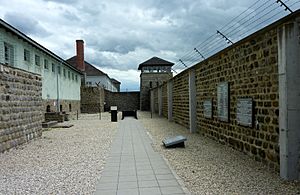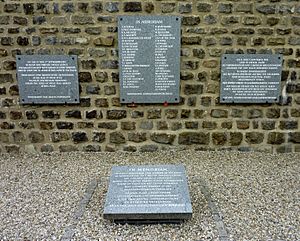Englandspiel facts for kids

The Englandspiel (which means England Game), also called Operation North Pole, was a clever secret operation by German military intelligence (the German: Abwehr) during World War II. From 1942 to 1944, the Germans managed to trick the British. They caught many Allied spies who were working in the Netherlands. Then, they used the spies' secret radio codes to fool the United Kingdom's secret spy group, the Special Operations Executive (SOE).
The Germans made the SOE believe that their agents were still free. This led the British to keep sending more spies, weapons, and supplies into the Netherlands. Almost all of these agents and supplies were captured by the Germans. This was a huge disaster for the SOE and the Dutch resistance. Fifty-four SOE agents from England were caught by the Germans, and 50 of them were killed. The Dutch resistance was large, but it didn't have enough weapons. If they had been armed, they might have helped the Allied forces more in 1944.
Contents
How the Secret War Started
The Special Operations Executive (SOE) was a secret British group. It was created on July 22, 1940. British Prime Minister Winston Churchill wanted them to "set Europe ablaze." This meant they should cause trouble and damage in countries that Nazi Germany and other Axis powers had taken over. SOE agents worked with resistance groups in these countries. They sent them weapons and equipment by parachuting them from planes.
The SOE had a special section, called Section N, just for the Netherlands. This section was not always very good at its job. On the German side, the main people in charge of catching spies were Majors Hermann Giskes of the Abwehr (German military intelligence) and Joseph Schreieder of the Sicherheitsdienst (SD), which was the intelligence service of the SS.
The Netherlands was a difficult place for the British to send agents and supplies. It was very crowded and didn't have many forests or mountains where resistance fighters could hide. It was hard to find quiet places for planes to land or drop supplies. The coast was flat and guarded by Germans, so it was tough to bring things in by boat. Also, the Netherlands didn't share a border with any neutral country that could be used as a safe base.
Early Problems for the British
In late 1941, a Dutch spy working for another British intelligence group, MI6, was caught in the Netherlands. He had many secret messages with him. A German code-breaker, Sergeant E. G. May, learned the MI6 secret code system. In February 1942, two more MI6 agents were captured. This gave the Germans even more information about British codes. At this time, the SOE used MI6 for its communications and codes.
Meanwhile, the SOE was training Dutch agents to go into the Netherlands. These agents were supposed to help the growing resistance movement. But the agents complained that their training was not good enough. They were given clothes that looked clearly British, which would make them easy to spot in the Netherlands. Security was also weak. The SOE couldn't even give the agents names and addresses of people or safe houses they would need. The British kept these unhappy trainees locked up for a while. They were only released in December 1941 after the Dutch government-in-exile complained. The agents had to promise to keep quiet about their complaints.
The SOE's first two Dutch agents, radio operator Huub Lauwers and saboteur Thys Taconis, parachuted into the Netherlands on November 6, 1941. Lauwers was caught on March 6, 1942. The Germans convinced him to send messages to the SOE in London. But Lauwers left out two "security checks" from his messages. These were small, deliberate errors that only the agent and SOE knew about. If these checks were missing, it meant the agent was either fake or had been captured and forced to send messages. This was a very important warning signal!
However, the SOE in London ignored these missing security checks. They accepted the messages as real. Lauwers kept sending messages without the checks. He even put the letters CAU and GHT ("Caught") at the start and end of some messages. Still, SOE London paid no attention. The messages Lauwers sent as a prisoner included requests for more agents and supplies. The SOE kept sending them. Agents and supplies were usually flown from Britain at night. They were dropped by parachute from bombers or landed by small planes. The Germans were waiting for them and captured them as soon as they arrived.
The Germans Play the "England Game"
Several Dutch radio operators who had been captured kept sending secret messages. They did not include the security checks, which should have warned the SOE that they were under German control. Leo Marks, the SOE's head of codes, later said he realized that the Dutch messages were too perfect. Unlike other agents' messages, these had no errors. He thought this was because German experts were coding them, not hurried agents in the field.
Marks also noticed something else. In a radio message, a German operator ended with "HH," which stood for Heil Hitler. The person on the other end instantly replied "HH." This showed that the sender was a German who automatically added "HH" to messages, not a British agent. Finally, Marks sent a Dutch agent a message that was purposely messed up. Marks knew that a normal SOE agent couldn't decode it, but the German code-breakers could. When the "Dutch agent" replied to the garbled message, Marks knew he was under German control. Marks told his boss, but he was told not to talk about it. Nothing was done.
German radio operators pretended to be resistance groups and reported fake sabotage successes to SOE London. When SOE London asked an agent to return to England, something bad would suddenly happen to them, so they couldn't come back. In January 1943, Marks wrote a report to SOE leaders. He suspected that almost all SOE agents in the Netherlands were in German hands. But it took months for any action to be taken. The SOE leaders probably didn't want to believe the warning signs. Also, there was a rivalry between the SOE and another spy group, which might have stopped them from sharing information.
The End of the Game
In the fall of 1943, two Dutch SOE agents, Pieter Dourlein and John Ubbink, escaped from a German prison camp. They made their way to Switzerland and told the Dutch government there about the Englandspiel. This information was then passed to the British government. The two agents then traveled through Spain to London. However, the German officer Giskes, who was in charge of the Englandspiel, knew they were coming. He sent a fake message, pretending it was from another SOE agent. This message said that Dourlein and Ubbink were traitors working for the Germans. When they arrived in London, both agents were put in a British prison. They stayed there until after the Normandy invasion in June 1944. Later, the Dutch government honored them.
The Englandspiel was already ending in late 1943. The Royal Air Force (RAF), which provided planes for the SOE, had stopped flights to the Netherlands after May 1943. This was because too many planes and pilots were being lost. The RAF had noticed that their flights to the Netherlands always arrived easily, and the landing areas were "too perfect." But the planes were often shot at on their way back to England and suffered many losses. In less than a year, 12 RAF planes were shot down returning from SOE missions in the Netherlands.
The Englandspiel finally ended on April 1, 1944. Giskes sent a mocking message to the SOE. He complained that they hadn't sent him any "business" lately, since he had been "serving" them for so long. Giskes' message also promised a warm welcome to any new agents the SOE wanted to send to the Netherlands.
What Happened Next
The fifty Dutch SOE agents who had been captured by the Germans were sent to Mauthausen concentration camp in September 1944. This happened as Allied forces were moving into the Netherlands. Eventually, these agents were killed. Giskes, the German officer behind the Englandspiel, was arrested by the British. But after the war, he worked for the United States during the occupation of Germany.
Some officials from the Dutch government-in-exile in London refused to work with the SOE after they learned about the Englandspiel. But the Dutch Prince Bernhard ordered them to cooperate. A fresh start was made in mid-to-late 1944 with new leaders at the SOE. Twenty-five well-trained Dutch sabotage teams, each with two agents, were parachuted into the Netherlands.
However, because of the Englandspiel, the British didn't trust the Dutch resistance. This stopped the resistance from helping much in Operation Market Garden. This was an unsuccessful attack by Allied forces in the Netherlands in September 1944. The main British forces were told not to work with the resistance. If they had, the resistance could have given them important information and helped with communications. This might have saved the British division from heavy losses.
Some people in the Netherlands believed that a traitor in the SOE caused the Englandspiel. They thought Dutch agents were sacrificed to hide Allied plans for an invasion. For many, it was hard to believe that such a disaster could happen just because of mistakes and bad planning. But the more accepted idea is that the agents were caught because the Germans were good at police work, and the British and Dutch in London made many mistakes.
Agents Involved

During the Englandspiel, many agents were dropped into the Netherlands and captured. Here are a few examples:
- August 28, 1940: Lodo van Hamel, sent to Oegstgeest.
- July 5, 1941: Aart Alblas, dropped near Nieuweschans. He was arrested on July 16, 1942.
- November 6, 1941: Huub Lauwers and Thijs Taconis, dropped near Ommen. Lauwers was arrested on March 6, 1942, and Taconis on March 9, 1942.
- December 9, 1941: Wim van der Reijden, sent to Scheveningen. He was arrested on February 13, 1942.
- February 23, 1942: Evert Radema and E.W. de Jonge, sent to Katwijk aan Zee. Radema was arrested on May 29, 1942, and De Jonge on May 22, 1942.
- February 28, 1942: Gerrit Dessing, dropped near Ermelo. He managed to return to England on September 2, 1943.
- March 27, 1942: Nol Baatsen, dropped near Kallenkote and arrested right away.
- February 19, 1943: Pieter Dourlein, dropped near Ermelo and arrested immediately. He later escaped and reported the Englandspiel.



